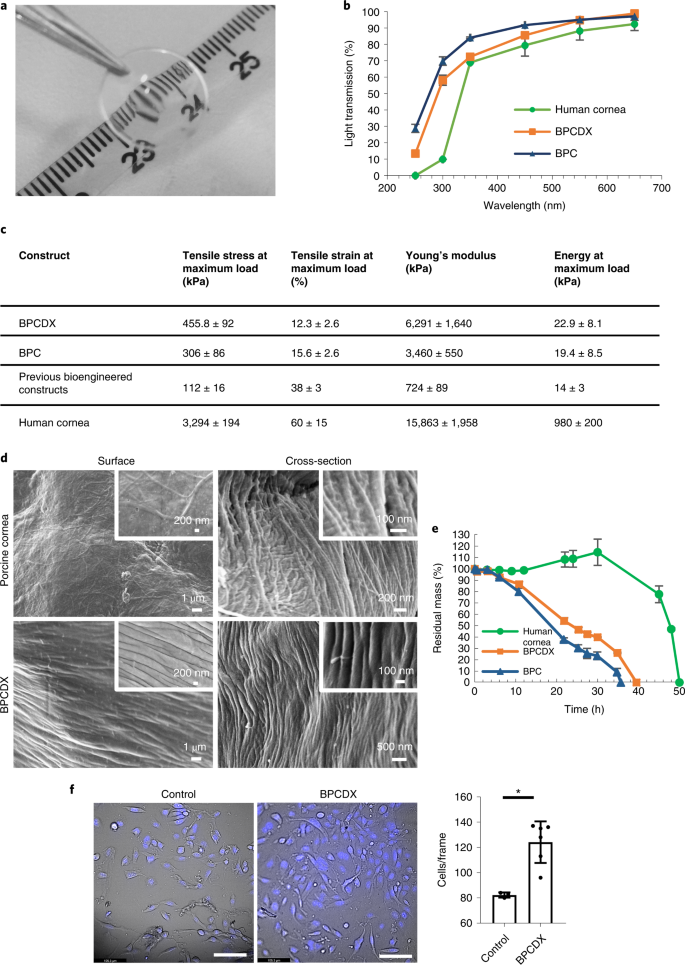2022-08-11 スウェーデン・リンショーピング大学
“ヒト用インプラント “として使用するための基準をすべて満たした生体材料を開発し、大量生産して2年間保存することで、さらに多くの視力障害者に届けることが可能であることを示す結果となりました。
研究者たちは、ヒト用に高度に精製され、厳しい条件のもとで生産された豚の皮膚由来のコラーゲン分子を使用した。眼球への移植に提供された角膜は2週間以内に使用しなければならないが、バイオエンジニアリングされた角膜は使用前に最大2年間保存することができる。
角膜が薄くなり失明に至ることもある円錐角膜という病気に対して、低侵襲で治療できる新しい方法を開発しました。
より侵襲性の低い方法であれば、より多くの病院で使用することができ、より多くの人を救うことができる。外科医は患者さん自身の組織を切除する必要は無く、小さな切開を行い、そこからインプラントを既存の角膜に挿入する。
この新しい手術法では、縫合は必要ありません。角膜の切開は、最先端のレーザーで高精度に行うことができますが、必要であれば、簡単な手術器具を使って手作業で行うこともできます。この方法は、まず豚で実験され、従来の角膜移植よりも簡単で安全である可能性があることが判明した。
<関連情報>
- https://liu.se/en/news-item/biokonstruerad-hornhinna-kan-ge-blinda-synen-ater
- https://www.nature.com/articles/s41587-022-01408-w
進行した円錐角膜における低侵襲な視力回復のためのバイオ人工角膜組織の2つの臨床コホート Bioengineered corneal tissue for minimally invasive vision restoration in advanced keratoconus in two clinical cohorts
Mehrdad Rafat,Mahmoud Jabbarvand,Namrata Sharma,Maria Xeroudaki,Shideh Tabe,Raha Omrani,Muthukumar Thangavelu,Anthony Mukwaya,Per Fagerholm,Anton Lennikov,Farshad Askarizadeh & Neil Lagali
Nature Biotechnology Published:11 August 2022
DOI:https://doi.org/10.1038/s41587-022-01408-w

Abstract
Visual impairment from corneal stromal disease affects millions worldwide. We describe a cell-free engineered corneal tissue, bioengineered porcine construct, double crosslinked (BPCDX) and a minimally invasive surgical method for its implantation. In a pilot feasibility study in India and Iran (clinicaltrials.gov no. NCT04653922), we implanted BPCDX in 20 advanced keratoconus subjects to reshape the native corneal stroma without removing existing tissue or using sutures. During 24 months of follow-up, no adverse event was observed. We document improvements in corneal thickness (mean increase of 209 ± 18 µm in India, 285 ± 99 µm in Iran), maximum keratometry (mean decrease of 13.9 ± 7.9 D in India and 11.2 ± 8.9 D in Iran) and visual acuity (to a mean contact-lens-corrected acuity of 20/26 in India and spectacle-corrected acuity of 20/58 in Iran). Fourteen of 14 initially blind subjects had a final mean best-corrected vision (spectacle or contact lens) of 20/36 and restored tolerance to contact lens wear. This work demonstrates restoration of vision using an approach that is potentially equally effective, safer, simpler and more broadly available than donor cornea transplantation.


